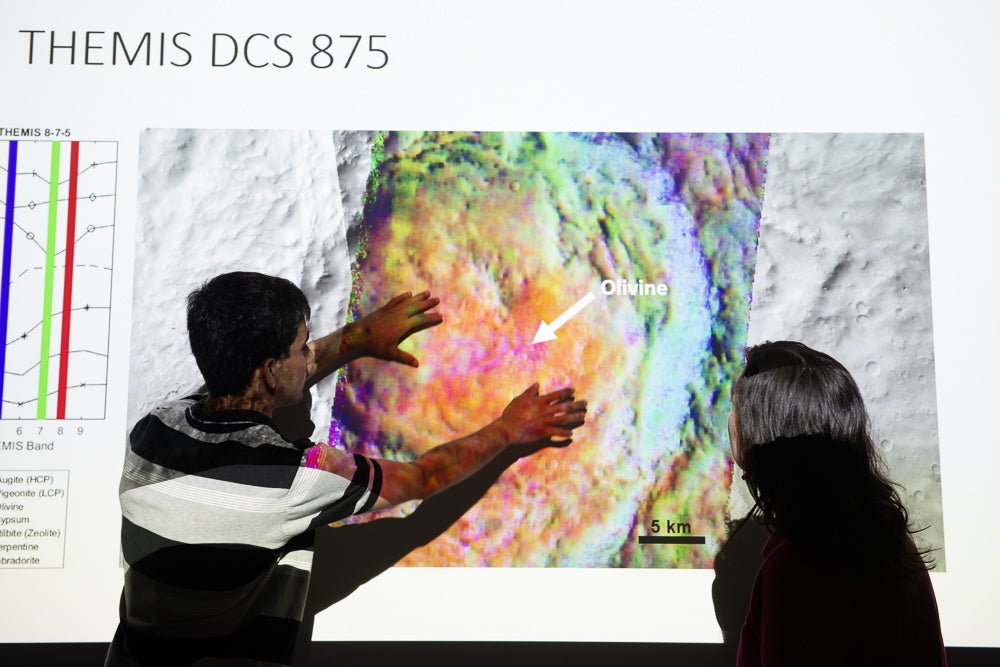Ever since he was 4, Aditya Khuller has dreamed about exploring the vast frontiers of space.
First it was the study of stars, but he wasn’t sure if he wanted to be a professor to support his research. So he chose the path of an aerospace engineer and led a team of Arizona State University students that built an innovative small satellite propulsion system: a multiple-axis pulsed plasma thruster, "trying to do something that had not been done before."
Khuller became hooked after taking an introductory class taught by ASU’s Phil Christensen, Regents Professor in the School of Earth and Space Exploration.
“He talked about the Mars space flight program at ASU, his work on instruments for NASA, and what he does for their missions,” Khuller says. “I had never heard anything this fascinating.”
During the past three summers, Khuller delved further into the study of Mars as an intern at NASA’s Jet Propulsion Lab in Pasadena, California. This summer, Khuller’s work on a Martian dune project with NASA Mars Program Office Scientist Serina Diniega involved understanding and characterizing the formation of sand dunes on Mars and comparing them with dunes on Earth. Their work could help determine how wind can affect surfaces on different planets, with implications for future manned missions to Mars.
Khuller spent the majority of his time at JPL examining a host of data from orbiting Mars spacecraft, ranging from visible imagery to assess morphology, coupled with thermal/near-infrared spectral data to infer physical properties and composition.
“It’s been fun seeing the outcomes of combining this wealth of orbital spacecraft data to start to put together a coherent formation mechanism for Martian dune formation,” he says.
Aditya Khuller spent the majority of his time at the Jet Propulsion Laboratory examining a host of data from orbiting Mars spacecraft, ranging from visible imagery to assess morphology, coupled with thermal/near-infrared spectral data to infer physical properties and composition. Photo by Jarod Opperman/ASU
Khuller continues work on his doctorate in planetary science and geology under Christensen. His goal is to combine his experiences from engineering and science to become a research scientist in planetary science, while having the opportunity to work on active NASA missions.
“I hope to integrate this experience into my career as I begin my PhD,” he says. “Aeolian geology (dunes, yardangs, etc.) is a very interesting side of planetary geology that I have only delved into briefly during my first internship at JPL two years ago (under Research Scientist Laura Kerber), and I look forward to learning more under Diniega’s guidance.”
Khuller, a Barrett Community Scholar and Greeley Planetary Geology scholar, credits Christensen and ASU for making his dreams come true.
“I’m an international student from India, because of which I’m extremely limited by the types of financial aid, scholarships and opportunities I can apply to,” he says. “To get support from ASU and Barrett is fantastic, and I’m really grateful for these opportunities. I feel like I am part of a family here.”
Written by Ellen Chang. Top photo: For three summers, Aditya Khuller studied Mars as an intern at NASA’s Jet Propulsion Lab in Pasadena, California. Photo by Jarod Opperman/ASU
More Science and technology

Indigenous geneticists build unprecedented research community at ASU
When Krystal Tsosie (Diné) was an undergraduate at Arizona State University, there were no Indigenous faculty she could look to in any science department. In 2022, after getting her PhD in genomics…

Pioneering professor of cultural evolution pens essays for leading academic journals
When Robert Boyd wrote his 1985 book “Culture and the Evolutionary Process,” cultural evolution was not considered a true scientific topic. But over the past half-century, human culture and cultural…

Lucy's lasting legacy: Donald Johanson reflects on the discovery of a lifetime
Fifty years ago, in the dusty hills of Hadar, Ethiopia, a young paleoanthropologist, Donald Johanson, discovered what would become one of the most famous fossil skeletons of our lifetime — the 3.2…

